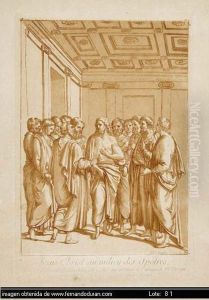Francois Philippe Charpentier Paintings
François-Philippe Charpentier was a French engraver and inventor born on April 17, 1734, in Blois, France. He is most notably recognized for his contributions to the field of engraving and printmaking. Charpentier was an innovative figure in the arts and sciences, blending his technical skills with his artistic sensibilities to enhance the processes involved in engraving.
Charpentier's early life is not extensively documented, but it is known that he moved to Paris to pursue his career. His initial work focused on engraving, and he became quite skilled in this craft. However, his most significant contribution to the arts was his development of a mechanical engraving machine that could engrave letters and images into copper plates, which greatly facilitated the reproduction of maps and texts. His invention was a precursor to modern printing techniques and had a lasting impact on how printed materials were produced.
Throughout his career, Charpentier also showed a keen interest in science and mechanics, which was reflected in his diverse range of inventions. In addition to his engraving machine, he developed a pyrometer, an instrument for measuring high temperatures, which was particularly useful in scientific experiments and industrial processes. His work in this area demonstrated his ability to apply his technical knowledge to practical problems, making him a respected figure both among his artistic peers and within scientific circles.
Charpentier's contributions to engraving technology earned him recognition from the French Academy of Sciences. Despite his technical achievements, he did not gain the same level of fame as some of his contemporaries in the art world. Nevertheless, his work had a lasting influence on the fields of printing and engraving, and he is remembered as a pioneer who bridged the gap between art and technology.
François-Philippe Charpentier passed away on August 8, 1817, in Paris. His legacy is carried on through his inventions, which helped pave the way for the mass production of printed materials, thereby democratizing access to information and knowledge. Although he may not be a household name like some artists or inventors, his contributions continue to impact the worlds of art, science, and industry.

